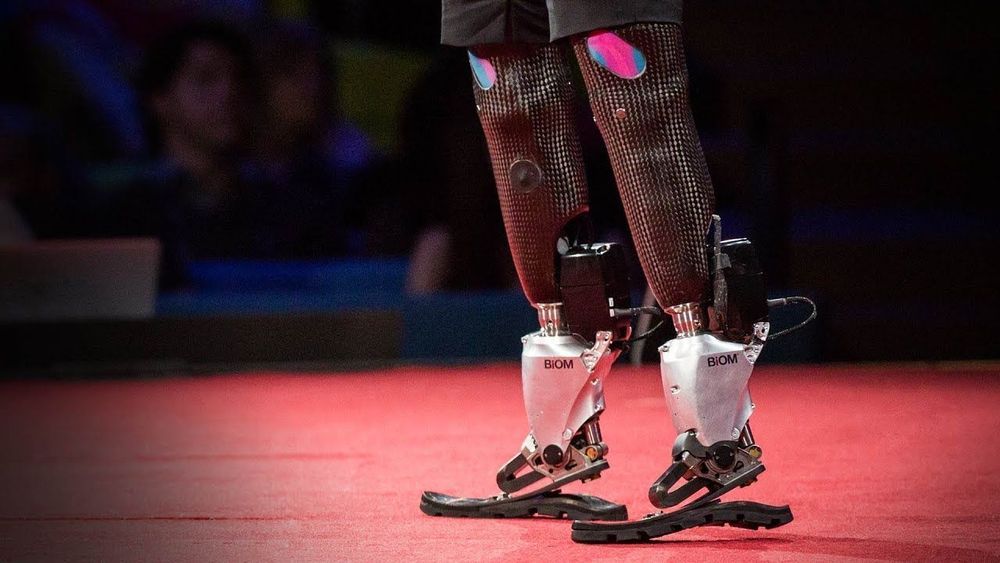Oct 21, 2020
U.S. Army self-healing material
Posted by Raphael Ramos in categories: biotech/medical, cyborgs
Self healing material is being developed for prosthetic limbs.
This material can help us make self-healing prosthetic limbs in the future.
Self healing material is being developed for prosthetic limbs.
This material can help us make self-healing prosthetic limbs in the future.
The absence of piezoelectricity in silicon makes direct electromechanical applications of this mainstream semiconductor impossible. Integrated electrical control of the silicon mechanics, however, would open up new perspectives for on-chip actuorics. Here, we combine wafer-scale nanoporosity in single-crystalline silicon with polymerization of an artificial muscle material inside pore space to synthesize a composite that shows macroscopic electrostrain in aqueous electrolyte. The voltage-strain coupling is three orders of magnitude larger than the best-performing ceramics in terms of piezoelectric actuation. We trace this huge electroactuation to the concerted action of 100 billions of nanopores per square centimeter cross section and to potential-dependent pressures of up to 150 atmospheres at the single-pore scale. The exceptionally small operation voltages (0.4 to 0.9 volts), along with the sustainable and biocompatible base materials, make this hybrid promising for bioactuator applications.
An electrochemical change in the oxidation state of polypyrrole (PPy) can increase or decrease the number of delocalized charges in its polymer backbone (1). Immersed in an electrolyte, this is also accompanied by a reversible counter-ion uptake or expulsion and thus with a marcroscopic contraction or swelling under electrical potential control, making PPy one of the most used artificial muscle materials (1–5).
Here, we combine this actuator polymer with the three-dimensional (3D) scaffold structure of nanoporous silicon (6–8) to design, similarly as found in many multiscale biological composites in nature (9), a material with embedded electrochemical actuation that consists of a few light and abundant elemental constituents (i.e., H, C, N, O, Si, and Cl).
Russian state-owned defense corporation Rostec has released footage of a brand-new combat exoskeleton for assault operations in action.
The video footage, published by Rostec on Monday, shows a Russian service member wielding firearms, climbing stairs, and rucking through wooded terrain while wearing the defense giant’s new ‘Shturmovik’ — or ‘Stormer’ — exoskeleton:
The Army is formally moving ahead with the development and fielding of a powered exoskeleton to help soldiers move faster and carry more while reducing overall fatigue after years of experimentation and testing.
Officials with Army Futures Command are currently in the process of drafting formal requirements for an infantry exoskeleton ahead of a defense industry day sometime in November, said Ted Maciuba, deputy director of the robotic requirements division for Army Futures Command.
Breaking Defense first reported news of the fresh exoskeleton effort.

Visit http://TED.com to get our entire library of TED Talks, transcripts, translations, personalized talk recommendations and more.
Hugh Herr is building the next generation of bionic limbs, robotic prosthetics inspired by nature’s own designs. Herr lost both legs in a climbing accident 30 years ago; now, as the head of the MIT Media Lab’s Biomechatronics group, he shows his incredible technology in a talk that’s both technical and deeply personal — with the help of ballroom dancer Adrianne Haslet-Davis, who lost her left leg in the 2013 Boston Marathon bombing, and performs again for the first time on the TED stage.
Continue reading “New bionics let us run, climb and dance | Hugh Herr” »
It’s essentially the guts of a smartphone combined with brain-implanted micro electrodes, as TechCrunch reports. The “Gennaris bionic vision system,” a project that’s more than ten years in the making, bypasses damaged optic nerves to allow signals to be transmitted from the retina to the vision center of the brain.
The system is made up of a custom-designed headgear, which includes a camera and a wireless transmitter. A processor unit takes care of data crunching, while a set of tiles implanted inside the brain deliver the signals.
“Our design creates a visual pattern from combinations of up to 172 spots of light (phosphenes) which provides information for the individual to navigate indoor and outdoor environments, and recognize the presence of people and objects around them,” Arthur Lowery, professor at Monash University’s Department of Electrical and Computer Systems Engineering, said in a statement.
But U.S. is not the only country engaged in human enhancement and transhumanism, as Russia and China are also in hot pursuit with exoskeletons, vaccines and brain implants. As this competition gains traction, one wonders what the future of their militaries may look like as human beings are steadily integrated with machines to become armies of iron man.
From the blog of Christina Lin at The Times of Israel.
Sarcos Robotics, a startup developing robots for industrial and defense applications, today nabbed $40 million in equity financing, bringing its total venture capital raised to nearly $100 million. The company plans to use the capital to commercialize its first full-body, self-powered product — the Guardian XO — ahead of an anticipated 2021 ship date.
According to a 2020 Grand View Research report, the exoskeleton market could be worth $4.2 billion by 2027. The firm sees adoption growing steeply in health care, where exoskeletons could address the increased prevalence of spinal cord injuries in industries like security, disaster recovery, infrastructure inspection and maintenance, maritime, oil and gas, and mining. The National SCI Statistical Center reported 17,730 new spinal cord injuries in 2019 in the U.S. alone.
Sarcos spun out from the University of Utah in 1983 and for years operated as a bioengineering research institution. By 2000, the lab had expanded into segments like animated film props, prostheses, and human-computer interfaces. A DARPA grant to develop a military exoskeleton steered Sarcos toward defense applications. After DARPA accepted Sarcos’ proposal in 2006, the company began developing prototypes and contracted with the U.S. Navy to pilot salvage robots.